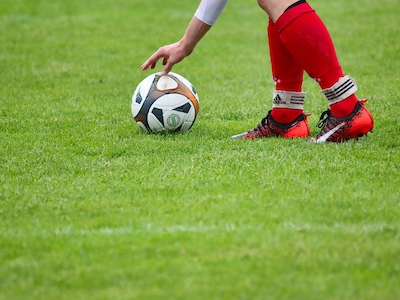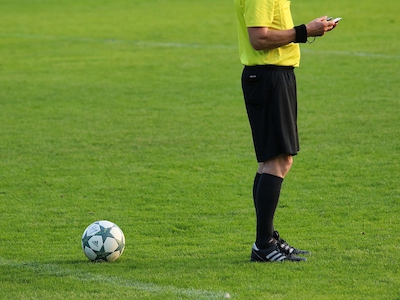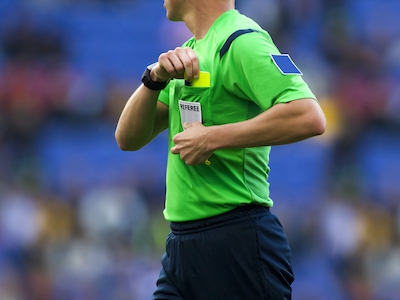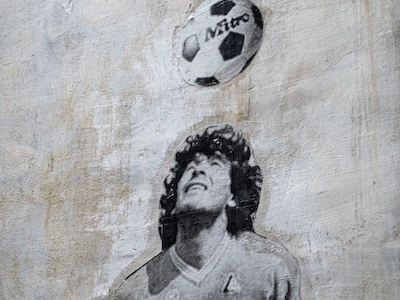Handball rule in football
One of the first things you learn as a first-time footballer is that you are not allowed to touch the ball with your hands. It sounds simple, but in practice, it turns out to be more difficult than you’d think. Hands is one of the most controversial rules in football. When is hands regulatory and when is it not? And in what situations is it unclear whether it was hands or not? You’ll read all the answers in this article.
Ground rules of hands in football
What does hands mean in football? Hands means that a player (other than the goalkeeper) touches the ball with their hand or part of their arm. In most cases, ball + arm is hands, except when a player receives the ball against his hand or arm while they are held along or in front of the body. So, even if the ball hits a footballer’s hand during a natural reflex – e.g., to protect one’s head – it is often seen as hands, even though it is an accidental handball.
Even the goalkeeper can make a handball. The keeper is only allowed to touch the ball with his hands when he’s in his penalty area, unless the ball is deliberately passed back to him. If the goalkeeper picks up the ball in such a situation, the opponent will get a penalty shot.
When is it considered a hand ball?
The answer to this question is not as simple as you might think. We first have to establish what falls under the concept of ‘arm’ in football. The official rules state that the arm starts from just beneath the armpits. If the ball touches the shoulder of the footballer, it doesn’t count as hands. If the ball lands on the boundary area between shoulder and arm, the referee and VAR need to determine whether it was hands or not. The final decision is made based on the referee’s own interpretation.
Handballs in attacking and defensive scenarios
Since 2010, there’s a difference in the assesment of handballs in attacking and defensive scenarios. The bottom line is that in defensive scenarios, the ball may legally touch the arm, provided it is in natural position. Is the ball touched in an attacking scenario and does this work beneficial for the footballer? Then it is always hands.
Handballs in attacking scenarios
The hands rule is most strict in attacking situations. No advantage may be gained by the ball hitting the arm. Not even when the arms are beside the body. The rule was introduced in 2020 and provides more clarity. Since the introduction of this rule, there has been less discussion on the pitch for this form of hands.
Handballs in defensive scenarios
Handballs in defensive situations are actually the total opposite of handballs in attacking situations. It is usally hands if the ball touches the arm when the arm is in an unnatural position. A natural position is when the arms are alongside the body. It’s not very natural because every human being acts on reflexes, but it’s assessed this way nonetheless. Only very occasionally hands is not given for reflexes of arms – due, for example, to a shot changing direction. Such decisions depend mainly on the interpretation of the referee and VAR.
When are yellow, or even red cards, given for a hand ball?
Basically, no card is drawn for unintentional hands unless the hands ball interrupts a promising attack. It is difficult for a referee to assess whether the player in question is deliberately holding his arm in an unnatural position or not. Therefore, a yellow card is sometimes and sometimes not drawn in similar situations.
In a few cases, an attempt at scoring a goal is taken away by a hands ball. For example, by Luis Suarez at the 2010 World Cup. Like a goalkeeper, he stopped the ball. In situations like that, there is only one thing for the referee to do: draw a red card.
Examples of hand balls
In the following three examples, you’ll get a clear picture of what hands is and in what degree the interpretation of the referee and the VAR is decisive.
1. Penalty for Everton
In this summary of the Crystal Palace v Everton match, you can see the ball sails into Crystal Palace's penalty area at around 0.53 seconds. Then, two metres away, an Everton player kicks the ball hard against the arm of a Palace defender. VAR intervenes and the referee decides to watch himself. The verdict? Penalty for Everton because the defender’s arm wasn’t in a natural position. Whether he can really do anything about this is the question.
2. The ball touches the arm, but it's not counted as hands
In the Manchester United v Liverpool match, a corner is kicked in front of the goal in minute 25. Afterwards, a Liverpool player shoots the ball against the hands of Manchester player McTominay. Players appeal for hands, but it wasn't hands. McTominay actually had his hands in front/beside his body, and in a defensive situation like this it can never be hands. The following situation with Bailly has nothing to do with hands. This is purely about the first part of the video.
3. Penalty for Portugal during the World Cup in Qatar
Portugal played a group match against Uruguay during the World Cup in Qatar. In minute 87, the ball gets shot into the penalty area of Uruguay by a Portuguese player. A Uruguayan falls and the ball touches his arm in the process. Footballers appeal for hands, and the VAR advises the referee to review the event. Even though the footballer wasn’t really able to do anything else with his arms during his fall, Portugal is given a penalty.
Most famous hand ball ever: the hand of God
In the history of football, there is one world-famous handball that will never be forgotten. We're talking about Diego Maradona’s handball during the quarter finals of the World Cup in 1986, a match played between Argentina and England. A handball also known as "the hand of God", referring to the Michelangelo’s painting ‘The Creation of Adam’. Argentina was the one who finally won the World Cup, partly because of this famous handball by the best footballer in the world at the time. It was an iconic moment awed by the entire football world. There’s no chance of this ever happening again with the introduction of the VAR.







